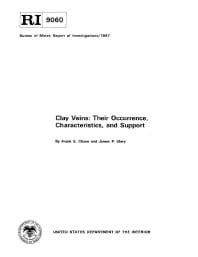Mining Publication: Clay Veins: Their Occurrence, Characteristics, and Support
Original creation date: January 1987
Authors: FE Chase, JP Ulery
NIOSHTIC2 Number: 10005605
Pittsburgh, PA: U.S. Department of the Interior, Bureau of Mines, RI 9060, 1987 Jan; :1-19
Clay veins found in coal mines have caused numerous injuries and fatalities. These structures plague all phases of mining, including entry development, pillar recovery, and panel extraction. Clay veins also increase production costs and may disrupt or halt mining. These detrimental aspects have prompted the Bureau of Mines to investigate the physical characteristics of and roof instability problems associated with clay veins. This was accomplished by observing and mapping clay veins in surface and underground mines. The occurrence and origins of clay veins were also investigated to determine predictive capabilities. The investigators found that clay veins normally occur in more stable, less rapidly subsiding coal basins. Clay veins result when tensile stresses develop fissures that are later infilled. These fissures can be propagated by compactional processes and/or tectonic stresses during and subsequent to coalification. The Bureau also found that associated faults, fractures, and slickenside planes commonly parallel clay veins and disrupt the lateral continuity of the immediate and, sometimes, main roof. When clay veins parallel or subparallel the direction of face advance, the roof is segmented into cantilever beams, causing unstable conditions. Consequently, the strata on either side of the clay veins should be bolted and strapped together to form a beam.

NIOSHTIC2 Number: 10005605
Pittsburgh, PA: U.S. Department of the Interior, Bureau of Mines, RI 9060, 1987 Jan; :1-19